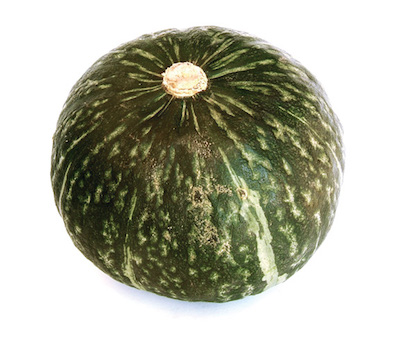Why this hobak porridge is not too hot, not too cold, but just right.
by Namju Cho
photograph by Eric Sueyoshi
As the weather turns chilly, even in Los Angeles, I immediately crave a comfort food that warms the soul. In other words, I’ve got hobakjuk (pumpkin porridge) on my mind.
These days, people enjoy a bowl of juk (porridge) as a snack or chicken soup equivalent when one is not feeling well. But starting in the 18th century, when white rice was in short supply and stretching scarce food was considered a virtue, it was consumed for survival. My mother remembers eating all different kinds of juk during the Korean War.
There are more than 30 different varieties of porridge, largely divided into rice juk, vegetarian (mostly bean) juk, and meat or fish juk. What makes juk juk is that it contains some form of rice, either plain or ground. The mushy consistency is known to facilitate digestion. Some protein-packed versions, like those made with abalone or chicken, are the star juks, the fancy ones not only touted as energy boosters for the elderly or frail, but also valued as a low-calorie meal fit for dieters.
I’ve always had a soft spot for hobakjuk, with its beautiful, deep orange-hued goodness, laced with gems like red bean and chestnuts. My mother used to make it for my sisters and me as a snack on those freezing winter days in Seoul. Once she started boiling the pumpkin, its sweet aroma would permeate the entire house.
Today, though far from Korea, I re-create those same comforting feelings with my own pot of hobakjuk, and I gladly share the recipe with you. (Recipe after the jump.)
Hobakjuk (serves 4)
1 lb kabocha squash (may substitute with orange-skinned pumpkin)
1/2 cup sticky rice (may substitute with white short-grained rice)
1/2 cup agave (may substitute with sugar)
1 cup red bean (optional)
1/2 cup cooked and peeled chestnuts, chopped (optional)
1. Wash the sticky rice in a bowl and soak in water for at least an hour.
Cut the squash into six wedges, remove seeds and place in a steamer.
Bring water to a boil and steam until squash is soft and a chopstick can poke through the flesh with no resistance, about 20-30 minutes.
2. Meanwhile, boil red beans in 5 cups of water.
When the water comes to a boil, discard all the liquid and return the red beans to the pot with another 5 cups of water.
Bring to a boil again.
This time, lower heat to a simmer and cook until tender, about 30 minutes.
3. When the squash is ready, place in a bowl and roughly mash with a fork.
Remove the skin, unless you (like me) don’t mind consuming green juk that gets its color from the skin.
Place the mashed squash in a pot.
Add water from the steam bath (about 1:1 ratio to the squash) so it’s the consistency of pancake batter, and stir under medium-low heat until well-mixed.
4. Purée the sticky rice in a food processor with a little bit of the water used for soaking.
Then slowly stir into the squash mix.
Keep stirring, adding more water if the mixture gets too thick.
Make sure to keep stirring, or the rice may congeal and stick to the bottom of the pot.
Add the agave.
5. Continue stirring until everything is well incorporated, about 15-20 minutes.
Using a hand blender (a regular blender works, too), purée the squash and rice mixture until it becomes smooth.
Add the red beans, then the chestnuts.
Stir.
Add agave to taste and serve










